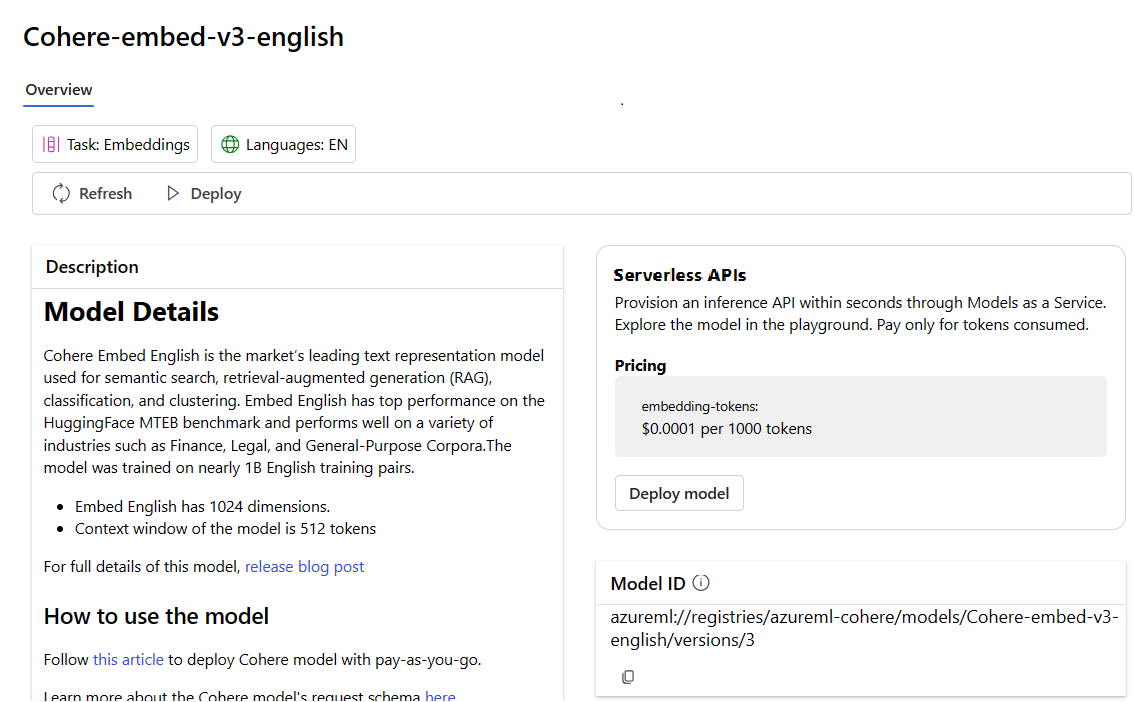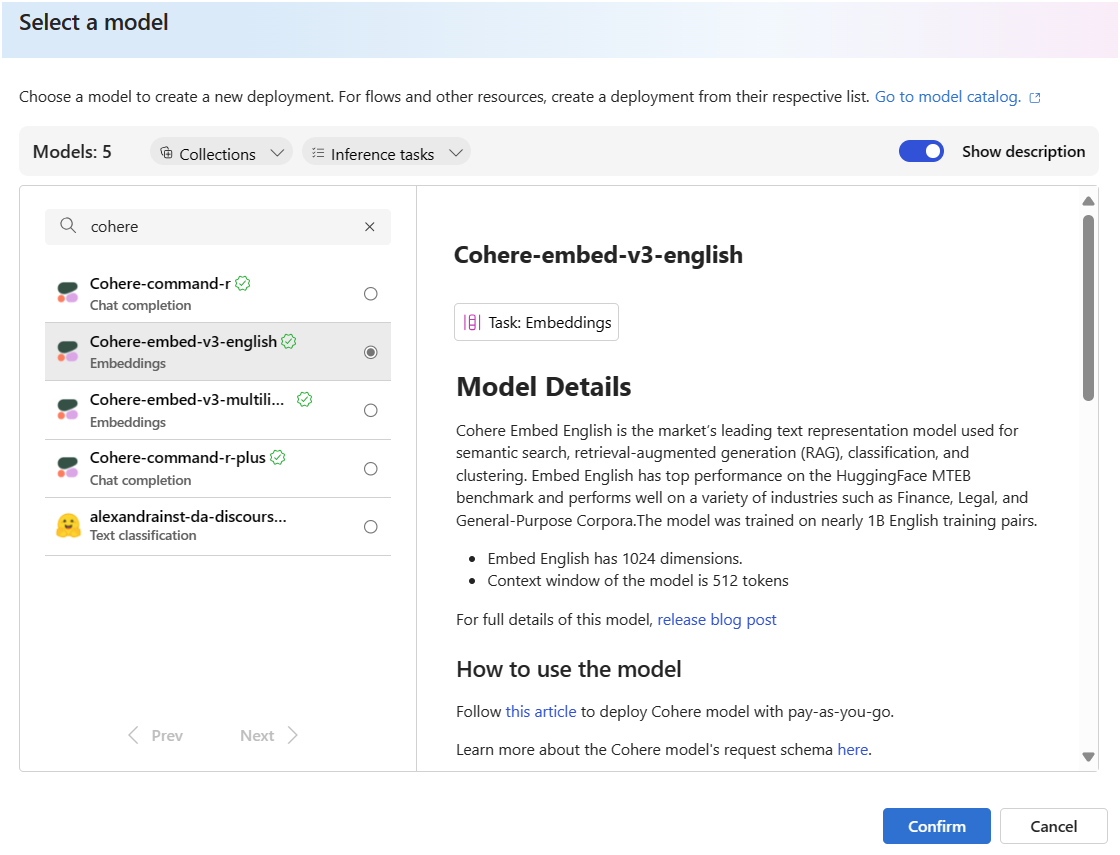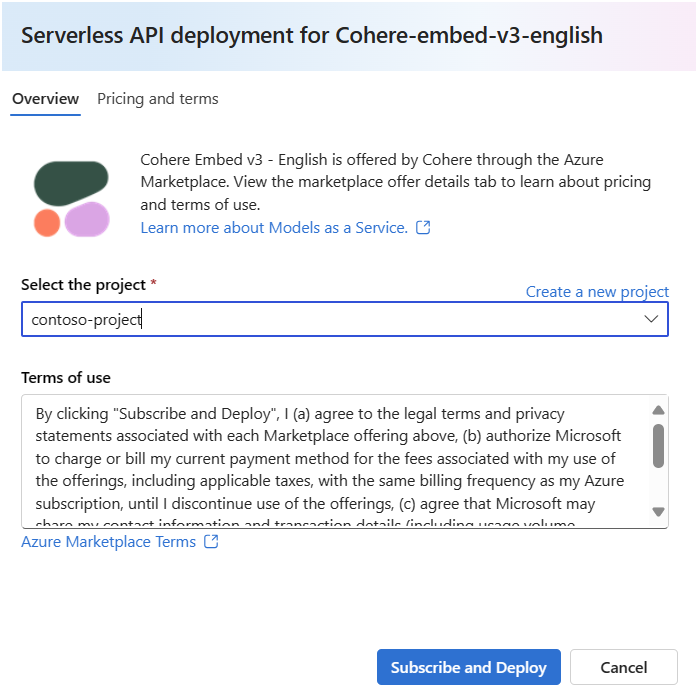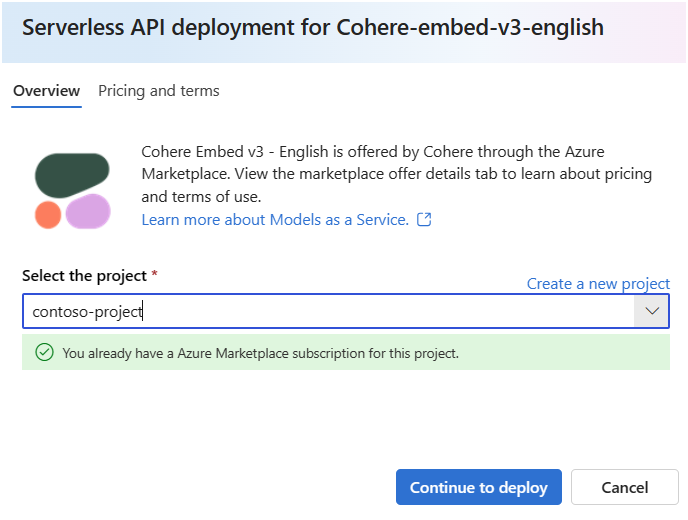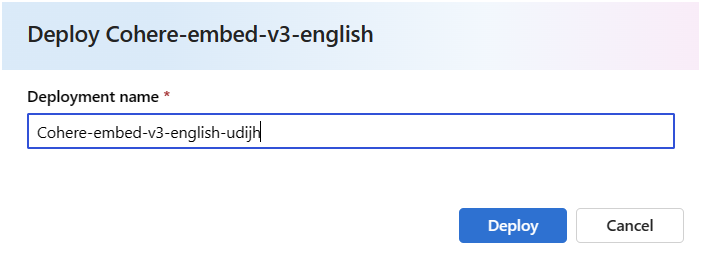How to deploy Cohere Embed models with Azure AI Studio
Important
Some of the features described in this article might only be available in preview. This preview is provided without a service-level agreement, and we don't recommend it for production workloads. Certain features might not be supported or might have constrained capabilities. For more information, see Supplemental Terms of Use for Microsoft Azure Previews.
In this article, you learn how to use Azure AI Studio to deploy the Cohere Embed models as serverless APIs with pay-as-you-go token-based billing.
Cohere offers two Embed models in Azure AI Studio. These models are available as serverless APIs with pay-as-you-go token-based billing. You can browse the Cohere family of models in the Model Catalog by filtering on the Cohere collection.
Cohere Embed models
In this section, you learn about the two Cohere Embed models that are available in the model catalog:
- Cohere Embed v3 - English
- Cohere Embed v3 - Multilingual
You can browse the Cohere family of models in the Model Catalog by filtering on the Cohere collection.
Cohere Embed v3 - English
Cohere Embed English is the market's leading text representation model used for semantic search, retrieval-augmented generation (RAG), classification, and clustering. Embed English has top performance on the HuggingFace MTEB benchmark and performs well on use-cases for various industries, such as Finance, Legal, and General-Purpose Corpora. Embed English also has the following attributes:
- Embed English has 1,024 dimensions.
- Context window of the model is 512 tokens
Cohere Embed v3 - Multilingual
Cohere Embed Multilingual is the market's leading text representation model used for semantic search, retrieval-augmented generation (RAG), classification, and clustering. Embed Multilingual supports 100+ languages and can be used to search within a language (for example, search with a French query on French documents) and across languages (for example, search with an English query on Chinese documents). Embed multilingual has state-of-the-art performance on multilingual benchmarks such as Miracl. Embed Multilingual also has the following attributes:
- Embed Multilingual has 1,024 dimensions.
- Context window of the model is 512 tokens
Deploy as a serverless API
Certain models in the model catalog can be deployed as a serverless API with pay-as-you-go billing. This kind of deployment provides a way to consume models as an API without hosting them on your subscription, while keeping the enterprise security and compliance that organizations need. This deployment option doesn't require quota from your subscription.
The previously mentioned Cohere models can be deployed as a service with pay-as-you-go billing and are offered by Cohere through the Microsoft Azure Marketplace. Cohere can change or update the terms of use and pricing of these models.
Prerequisites
An Azure subscription with a valid payment method. Free or trial Azure subscriptions won't work. If you don't have an Azure subscription, create a paid Azure account to begin.
An AI Studio hub. The serverless API model deployment offering for Cohere Embed is only available with hubs created in these regions:
- East US
- East US 2
- North Central US
- South Central US
- West US
- West US 3
- Sweden Central
For a list of regions that are available for each of the models supporting serverless API endpoint deployments, see Region availability for models in serverless API endpoints.
An AI Studio project in Azure AI Studio.
Azure role-based access controls are used to grant access to operations in Azure AI Studio. To perform the steps in this article, your user account must be assigned the Azure AI Developer role on the resource group. For more information on permissions, see Role-based access control in Azure AI Studio.
Create a new deployment
The following steps demonstrate the deployment of Cohere Embed v3 - English, but you can use the same steps to deploy Cohere Embed v3 - Multilingual by replacing the model name.
To create a deployment:
Sign in to Azure AI Studio.
Select Model catalog from the left sidebar.
Search for Cohere.
Select Cohere-embed-v3-english to open the Model Details page.
Select Deploy to open a serverless API deployment window for the model.
Alternatively, you can initiate a deployment by starting from your project in AI Studio.
From the left sidebar of your project, select Components > Deployments.
Select + Create deployment.
Search for and select Cohere-embed-v3-english. to open the Model Details page.
Select Confirm to open a serverless API deployment window for the model.
Select the project in which you want to deploy your model. To deploy the model your project must be in the EastUS2 or Sweden Central region.
In the deployment wizard, select the link to Azure Marketplace Terms to learn more about the terms of use.
Select the Pricing and terms tab to learn about pricing for the selected model.
Select the Subscribe and Deploy button. If this is your first time deploying the model in the project, you have to subscribe your project for the particular offering. This step requires that your account has the Azure AI Developer role permissions on the resource group, as listed in the prerequisites. Each project has its own subscription to the particular Azure Marketplace offering of the model, which allows you to control and monitor spending. Currently, you can have only one deployment for each model within a project.
Once you subscribe the project for the particular Azure Marketplace offering, subsequent deployments of the same offering in the same project don't require subscribing again. If this scenario applies to you, there's a Continue to deploy option to select.
Give the deployment a name. This name becomes part of the deployment API URL. This URL must be unique in each Azure region.
Select Deploy. Wait until the deployment is ready and you're redirected to the Deployments page.
Select Open in playground to start interacting with the model.
Return to the Deployments page, select the deployment, and note the endpoint's Target URL and the Secret Key. For more information on using the APIs, see the reference section.
You can always find the endpoint's details, URL, and access keys by navigating to your Project overview page. Then, from the left sidebar of your project, select Components > Deployments.
To learn about billing for the Cohere models deployed as a serverless API with pay-as-you-go token-based billing, see Cost and quota considerations for Cohere models deployed as a service.
Consume the Cohere Embed models as a service
These models can be consumed using the embed API.
From your Project overview page, go to the left sidebar and select Components > Deployments.
Find and select the deployment you created.
Copy the Target URL and the Key value.
Cohere exposes two routes for inference with the Embed v3 - English and Embed v3 - Multilingual models.
v1/embeddingsadheres to the Azure AI Generative Messages API schema, andv1/embedsupports Cohere's native API schema.For more information on using the APIs, see the reference section.
Embed API reference for Cohere Embed models deployed as a service
Cohere Embed v3 - English and Embed v3 - Multilingual accept both the Azure AI Model Inference API on the route /embeddings and the native Cohere Embed v3 API on /embed.
Azure AI Model Inference API
The Azure AI Model Inference API schema can be found in the reference for Embeddings article and an OpenAPI specification can be obtained from the endpoint itself.
Cohere Embed v3
The following contains details about Cohere Embed v3 API.
Request
POST /v1/embed HTTP/1.1
Host: <DEPLOYMENT_URI>
Authorization: Bearer <TOKEN>
Content-type: application/json
v1/embed request schema
Cohere Embed v3 - English and Embed v3 - Multilingual accept the following parameters for a v1/embed API call:
| Key | Type | Default | Description |
|---|---|---|---|
texts |
array of strings |
Required | An array of strings for the model to embed. Maximum number of texts per call is 96. We recommend reducing the length of each text to be under 512 tokens for optimal quality. |
input_type |
enum string |
Required | Prepends special tokens to differentiate each type from one another. You shouldn't mix different types together, except when mixing types for search and retrieval. In this case, embed your corpus with the search_document type and embedded queries with type search_query type. search_document – In search use-cases, use search_document when you encode documents for embeddings that you store in a vector database. search_query – Use search_query when querying your vector database to find relevant documents. classification – Use classification when using embeddings as an input to a text classifier. clustering – Use clustering to cluster the embeddings. |
truncate |
enum string |
NONE |
NONE – Returns an error when the input exceeds the maximum input token length. START – Discards the start of the input. END – Discards the end of the input. |
embedding_types |
array of strings |
float |
Specifies the types of embeddings you want to get back. Can be one or more of the following types. float, int8, uint8, binary, ubinary |
v1/embed response schema
Cohere Embed v3 - English and Embed v3 - Multilingual include the following fields in the response:
| Key | Type | Description |
|---|---|---|
response_type |
enum |
The response type. Returns embeddings_floats when embedding_types isn't specified, or returns embeddings_by_type when embeddings_types is specified. |
id |
integer |
An identifier for the response. |
embeddings |
array or array of objects |
An array of embeddings, where each embedding is an array of floats with 1,024 elements. The length of the embeddings array is the same as the length of the original texts array. |
texts |
array of strings |
The text entries for which embeddings were returned. |
meta |
string |
API usage data, including current version and billable tokens. |
For more information, see https://docs.cohere.com/reference/embed.
v1/embed examples
embeddings_floats Response
Request:
{
"input_type": "clustering",
"truncate": "START",
"texts":["hi", "hello"]
}
Response:
{
"id": "da7a104c-e504-4349-bcd4-4d69dfa02077",
"texts": [
"hi",
"hello"
],
"embeddings": [
[
...
],
[
...
]
],
"meta": {
"api_version": {
"version": "1"
},
"billed_units": {
"input_tokens": 2
}
},
"response_type": "embeddings_floats"
}
Embeddings_by_types response
Request:
{
"input_type": "clustering",
"embedding_types": ["int8", "binary"],
"truncate": "START",
"texts":["hi", "hello"]
}
Response:
{
"id": "b604881a-a5e1-4283-8c0d-acbd715bf144",
"texts": [
"hi",
"hello"
],
"embeddings": {
"binary": [
[
...
],
[
...
]
],
"int8": [
[
...
],
[
...
]
]
},
"meta": {
"api_version": {
"version": "1"
},
"billed_units": {
"input_tokens": 2
}
},
"response_type": "embeddings_by_type"
}
More inference examples
| Package | Sample Notebook |
|---|---|
| CLI using CURL and Python web requests | cohere-embed.ipynb |
| OpenAI SDK (experimental) | openaisdk.ipynb |
| LangChain | langchain.ipynb |
| Cohere SDK | cohere-sdk.ipynb |
| LiteLLM SDK | litellm.ipynb |
Retrieval Augmented Generation (RAG) and tool-use samples
| Description | Package | Sample Notebook |
|---|---|---|
| Create a local Facebook AI Similarity Search (FAISS) vector index, using Cohere embeddings - Langchain | langchain, langchain_cohere |
cohere_faiss_langchain_embed.ipynb |
| Use Cohere Command R/R+ to answer questions from data in local FAISS vector index - Langchain | langchain, langchain_cohere |
command_faiss_langchain.ipynb |
| Use Cohere Command R/R+ to answer questions from data in AI search vector index - Langchain | langchain, langchain_cohere |
cohere-aisearch-langchain-rag.ipynb |
| Use Cohere Command R/R+ to answer questions from data in AI search vector index - Cohere SDK | cohere, azure_search_documents |
cohere-aisearch-rag.ipynb |
| Command R+ tool/function calling, using LangChain | cohere, langchain, langchain_cohere |
command_tools-langchain.ipynb |
Cost and quotas
Cost and quota considerations for models deployed as a service
Cohere models deployed as a serverless API with pay-as-you-go billing are offered by Cohere through the Azure Marketplace and integrated with Azure AI Studio for use. You can find the Azure Marketplace pricing when deploying the model.
Each time a project subscribes to a given offer from the Azure Marketplace, a new resource is created to track the costs associated with its consumption. The same resource is used to track costs associated with inference; however, multiple meters are available to track each scenario independently.
For more information on how to track costs, see monitor costs for models offered throughout the Azure Marketplace.
Quota is managed per deployment. Each deployment has a rate limit of 200,000 tokens per minute and 1,000 API requests per minute. However, we currently limit one deployment per model per project. Contact Microsoft Azure Support if the current rate limits aren't sufficient for your scenarios.
Content filtering
Models deployed as a serverless API are protected by Azure AI Content Safety. With Azure AI content safety, both the prompt and completion pass through an ensemble of classification models aimed at detecting and preventing the output of harmful content. The content filtering system detects and takes action on specific categories of potentially harmful content in both input prompts and output completions. Learn more about content filtering here.
Related content
Feedback
Coming soon: Throughout 2024 we will be phasing out GitHub Issues as the feedback mechanism for content and replacing it with a new feedback system. For more information see: https://aka.ms/ContentUserFeedback.
Submit and view feedback for
